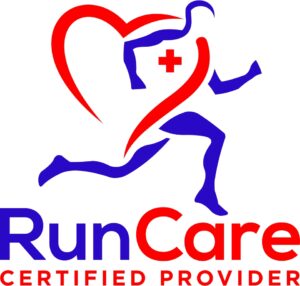
Ankle sprains are among the most common injuries, affecting millions annually. A sprained ankle occurs when the ankle ligaments around the ankle joint are stretched or torn, often due to awkward rolling or twisting of the foot. This injury can significantly impact your functional activities and daily life. Physical therapy is crucial for recovery, helping restore function, reduce pain, and prevent future running injuries. Physical therapists design specific programs that focus on these aspects, tailored to each individual’s needs. This article will cover the types of sprained ankles, their symptoms, and the specific ankle sprain exercises that can aid in recovery.
What is a Sprained Ankle
A sprained ankle occurs when the ankle ligaments supporting the joint are stretched beyond their normal range of motion, leading to tears or strains. This often results in an injured ankle that requires careful management for a full recovery. Sprained ankles typically happen when the foot rolls or twists awkwardly, causing the ligaments to stretch or tear.
Types of Sprained Ankle
Ankle sprains are classified into three grades based on their severity. Grade I, or mild sprains, involve minimal stretching or microscopic tears in the ligament fibers. Grade II, considered moderate, is marked by partial tears of the ligament. Finally, Grade III represents severe sprains, where there are complete tears or ruptures of the ligament, often necessitating more comprehensive medical treatment.
Common Symptoms
Symptoms of a sprained ankle typically include pain levels that intensify with movement or touch, swelling surrounding the ankle, bruising or discoloration, a restricted range of motion, and challenges in bearing weight on the injured foot.
The Role of Physical Therapy for Sprained Ankle Recovery
Physical therapy is essential in the recovery process for sprained ankles. It helps to restore normal function, enhance strength, and improve flexibility, which can be particularly important if a shoe causing ankle pain contributes to the injury. Effective physical therapy can also reduce the risk of future injuries, such as chronic ankle instability. With targeted exercise programs, patients can regain their mobility and confidence, returning to their regular activities and sports more swiftly.
Around 628,000 sprains occur annually, with lateral ankle sprains being the most common sports-related injury overall. Exercise therapy has proven effective in reducing the risk of recurrent sprains after an acute ankle sprain.
Physical Therapy Exercises for Sprained Ankle Rehabilitation

Range of Motion Exercises
Range of motion (ROM) exercises aim to regain flexibility and mobility in the ankle joint. These exercises play a crucial role in the rehabilitation process following a sprained ankle.
Ankle Alphabet
This exercise enhances flexibility in the ankle joint. It involves tracing the letters of the alphabet with your foot to promote movement in all directions, ensuring your foot is in a relaxed position throughout the exercise.
Step-by-Step Instructions:
- Sit comfortably with your leg extended.
- Use your toes to “write” the alphabet in the air.
- Perform this exercise 2-3 times a day.
Knee Motion
This exercise is designed to enhance mobility in both the knee and ankle joints. It targets flexibility and range of motion, contributing to overall lower limb function.
Step-by-Step Instructions:
- Sit in a chair with your feet flat on the ground.
- Slowly extend your knee, keeping your foot on the floor.
- Return to the starting position.
- Repeat 10-15 times for 2-3 sets.
Towel and Tissue Scrunches
These exercises target and strengthen the muscles surrounding the ankle, especially when incorporating a weighted object like a small dumbbell placed on the towel. Enhancing muscle support contributes to overall stability and recovery.
Step-by-Step Instructions:
- Place a towel or tissue on the floor in front of you.
- Use your toes to scrunch the towel or tissue toward you.
- Release and repeat 10-15 times for 2-3 sets.
Stretching Exercises
Stretching exercises are essential for relieving tension and enhancing flexibility in the muscles surrounding the ankle. These movements contribute to a more effective rehabilitation process after a sprain and ensure adequate pain relief during recovery.
Calf Stretch
This stretch focuses on the calf muscles, which are essential for maintaining ankle mobility. By targeting this area, you can improve flexibility and reduce tension in the ankle joint.
Step-by-Step Instructions:
- Stand facing a wall with one foot forward and the other foot extended back.
- Press your back heel into the floor and lean forward.
- Hold the stretch for 20-30 seconds and repeat 2-3 times.
Towel Stretch
This exercise enhances flexibility in both the Achilles tendon and calf muscles. As a result, it aids in pain relief and supports the overall recovery process.
Step-by-Step Instructions:
- Sit on the floor with your legs extended.
- Loop a towel around the ball of your foot and gently pull it toward you.
- Hold the stretch for 20-30 seconds and repeat 2-3 times.
Heel Raise
This exercise enhances the strength of the calf muscles while also boosting the stability of the ankle. By incorporating this movement into your routine, you can promote better balance and support for your sprained ankle, ultimately improving postural control.
Step-by-Step Instructions:
- Stand with your feet hip-width apart.
- Slowly raise your heels off the ground, balancing on the balls of your feet.
- Lower your heels back down.
- Repeat 10-15 times for 2-3 sets.
Strengthening Exercises
Strengthening exercises, such as ankle inversion and eversion movements, are designed to develop the muscles surrounding the ankle, enhancing joint support and stability. By targeting these muscles, you can facilitate a stronger recovery from a sprained ankle.
Ankle Eversion
This exercise targets the muscles that help rotate the foot outward. Strengthening these muscles is crucial for improving ankle stability and preventing future injuries.
Step-by-Step Instructions:
- Sit with your legs extended and place a resistance band around the ball of your foot.
- Gently push your foot outward against the band’s resistance.
- Slowly return to the starting position.
- Repeat 10-15 times for 2-3 sets.
4-Way Ankle Exercises
These exercises engage multiple muscle groups surrounding the ankle, particularly enhancing eversion strength, which is critical for stability. By working in different directions, they enhance overall strength and stability.
Step-by-Step Instructions:
- Attach a resistance band to a stable object and loop it around your foot.
- Perform movements in four directions: up, down, in, and out.
- Repeat each direction 10-15 times for 2-3 sets.
Clamshells
Physical therapy is vital for recovering from a sprained ankle, as it aids in restoring function, strength, and flexibility. By engaging in targeted exercises, individuals can enhance their mobility, reduce pain, and lower the risk of future injuries.
Step-by-Step Instructions:
- Lie on your side with your knees bent and feet together.
- Lift your top knee while keeping your feet together.
- Lower your knee back down.
- Repeat 10-15 times for 2-3 sets on each side.
Balance and Control Exercises
Balance and control exercises enhance coordination and diminish the risk of future injuries. Incorporating these movements into your rehabilitation routine is essential for long-term ankle stability.
Single-Leg Balance
This basic balance exercise improves balance while strengthening ankle stability. It is crucial for preventing future injuries, particularly for those with functional ankle instability.
Step-by-Step Instructions:
- Stand on one leg, keeping your other leg slightly bent.
- Hold this position for 20-30 seconds.
- Switch legs and repeat.
- Perform 2-3 sets on each leg.
Pillow Balance
This exercise improves your balance by introducing an element of instability. It effectively engages your core and ankle muscles, enhancing overall stability.
Step-by-Step Instructions:
- Stand on a pillow or soft surface with one leg.
- Hold the position at eye level for 20-30 seconds.
- Switch legs and repeat.
- Perform 2-3 sets on each leg.
When to Start Physical Therapy Exercises for Sprained Ankle

It’s crucial to start physical therapy exercises once the initial pain and swelling have subsided. Generally, this might be within a few days to a week after the injury, depending on the severity of the sprain. Consult with a health care professional, such as those in Physical Therapy Asheville NC, to determine the appropriate time to begin exercises and to receive a personalized rehabilitation program. Ankle braces can be a helpful support tool during the subacute phases of recovery to stabilize the ankle bones and prevent further injury.
Tips for a Successful Recovery
To ensure a successful recovery from a sprained ankle, it’s important to adhere to your therapist’s guidance by following the prescribed exercise routine and attending all scheduled therapy sessions. Gradually increase the intensity of your exercises to avoid the risk of re-injury, as muscle pain can be an indicator of overexertion. Remain consistent with your rehabilitation regimen to achieve optimal results. Proper footwear is essential; choose shoes that provide adequate support to help prevent recurrent ankle sprains and other injuries. Lastly, allow sufficient time for rest between exercises to avoid overuse and ensure your body has the opportunity to recover effectively, which is crucial during the acute phase of rehabilitation.
Conclusion
Physical therapy is a vital component in the recovery process for a sprained ankle. By incorporating targeted exercises to improve your range of motion, flexibility, strength, and balance, you can expedite your recovery and reduce the risk of future sprains. Remember, consistency and adherence to your physical therapy program are key to a successful recovery. Suppose you’re wondering how long is physical therapy for sprained ankle recovery. In that case, it varies depending on the severity of the injury but typically ranges from a few weeks to several months.
FAQ’S
Does physical therapy work for sprained ankle?
Yes, physical therapy is highly effective in treating sprained ankles. By addressing the underlying issues associated with the sprain, it helps reduce pain, improve function, and prevent recurrent injuries.
How do you rehab a sprained ankle?
To rehabilitate a sprained ankle, start by resting the joint, applying ice, and gradually incorporating range-of-motion exercises. As recovery progresses, add strengthening and balance exercises to restore functionality and prevent future injuries.
Should I exercise a sprained ankle?
Yes, exercising a sprained ankle is important for recovery. However, it’s essential to follow a proper rehabilitation plan to avoid aggravating the injury. Consult with a healthcare provider to ensure you’re performing exercises that are safe and effective for your specific condition.










